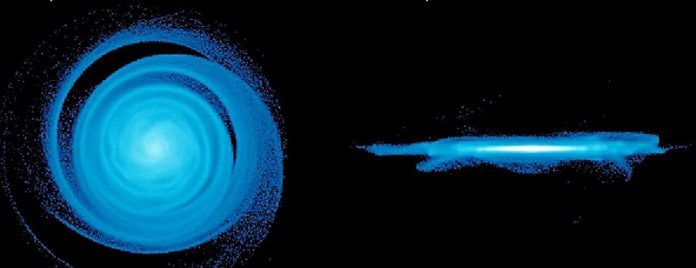
Astronomers have taken a groundbreaking look at an ancient galaxy far away, offering new insights into its formation and shedding light on the early days of the universe.
The galaxy in focus, BRI 1335-0417, is over 12 billion years old and holds the record as the oldest and most distant spiral galaxy known to us.
This remarkable study, led by Dr. Takafumi Tsukui and published in the Monthly Notices of the Royal Astronomical Society, has been made possible by the state-of-the-art ALMA telescope.
Dr. Tsukui and his team have delved into the movements of gas within BRI 1335-0417, a critical factor in understanding star formation in galaxies.
“Gas is a key ingredient for forming stars,” explains Dr. Tsukui.
The ability to see how gas moves and behaves in such an ancient galaxy offers valuable clues about how stars are born and how galaxies like our own Milky Way might have formed.
For the first time in such an early galaxy, the team observed a seismic wave forming, akin to ripples spreading on a pond’s surface.
This wave in the galaxy’s disk—a flat, rotating mass of stars, gas, and dust—is believed to be caused by external factors, such as new gas flowing into the galaxy or collisions with smaller galaxies. These events are crucial as they bring in new fuel for star formation.
Another significant find was a bar-like structure within the galaxy’s disk. Galactic bars are known to disrupt gas flow and transport it toward the galaxy’s center.
The discovery of such a bar in BRI 1335-0417 is notable because it’s the most distant one found to date. These findings together paint a picture of a young, dynamically growing galaxy.
Because BRI 1335-0417 is so far from Earth, the light we see from it today actually shows the galaxy as it was in its youth, when the universe was only about 10% of its current age.
This ‘time-travel’ aspect allows astronomers to study the conditions and processes of the early universe.
One intriguing aspect of early galaxies like BRI 1335-0417 is their rapid star formation. Associate Professor Emily Wisnioski, a co-author of the study, notes that despite having a mass similar to the Milky Way, BRI 1335-0417 forms stars at a rate several hundred times faster.
The team aimed to understand how such a galaxy could sustain this swift star creation.
Spiral galaxies were rare in the early universe, and their formation remains a mystery. This study provides crucial information on how these galaxies might have formed.
While it’s impossible to watch a galaxy evolve in real-time, as we only see a snapshot from Earth, computer simulations are used to piece together the galaxy’s history.
In summary, the discovery and analysis of BRI 1335-0417 offer an extraordinary glimpse into the past, helping scientists understand the early universe’s structure and evolution.
With advanced telescopes like ALMA, astronomers continue to uncover the secrets of the cosmos, one galaxy at a time.
Source: ANU.



